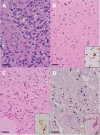Characteristics of H3 K27M-mutant gliomas in adults
- PMID: 28201752
- PMCID: PMC5570304
- DOI: 10.1093/neuonc/now274
Characteristics of H3 K27M-mutant gliomas in adults
Abstract
Background: Diffuse H3 K27M-mutant gliomas occur primarily in children but can also be encountered in adults. The aim of this study was to describe the characteristics of H3 K27M-mutant gliomas in adults.
Methods: We analyzed the characteristics of 21 adult H3 K27M-mutant gliomas and compared them with those of 135 adult diffuse gliomas without histone H3 and without isocitrate dehydrogenase (IDH) mutation (IDH/H3 wild type).
Results: The median age at diagnosis in H3 K27M-mutant gliomas was 32 years (range: 18-82 y). All tumors had a midline location (spinal cord n = 6, thalamus n = 5, brainstem n = 5, cerebellum n = 3, hypothalamus n = 1, and pineal region n = 1) and were IDH and BRAF-V600E wild type. The identification of an H3 K27M mutation significantly impacted the diagnosis in 3 patients (14%) for whom the histological aspect initially suggested a diffuse low-grade glioma and in 7 patients (33%) for whom pathological analysis hesitated between a diffuse glioma, ganglioglioma, or pilocytic astrocytoma. Compared with IDH/H3 wild-type gliomas, H3 K27M-mutant gliomas were diagnosed at an earlier age (32 vs 64 y, P < .001), always had a midline location (21/21 vs 21/130, P < .001), less frequently had a methylated MGMT promoter (1/21 vs 52/129, P = .002), and lacked EGFR amplification (0/21 vs 26/128, P = .02). The median survival was 19.6 months in H3 K27M-mutant gliomas and 17 months in IDH/H3 wild-type gliomas (P = .3).
Conclusion: In adults, as in children, H3 K27M mutations define a distinct subgroup of IDH wild-type gliomas characterized by a constant midline location, low rate of MGMT promoter methylation, and poor prognosis.
Keywords: H3 K27M; IDH; glioma; histone.
© The Author(s) 2017. Published by Oxford University Press on behalf of the Society for Neuro-Oncology. All rights reserved. For permissions, please e-mail: journals.permissions@oup.com
Figures



Comment in
-
H3 K27M-mutant glioma: clinical characteristics and outcomes.Neuro Oncol. 2019 Nov 4;21(11):1480-1481. doi: 10.1093/neuonc/noz135. Neuro Oncol. 2019. PMID: 31353394 Free PMC article. No abstract available.
-
Letter to the Editor.Neuro Oncol. 2019 Nov 4;21(11):1482. doi: 10.1093/neuonc/noz161. Neuro Oncol. 2019. PMID: 31648295 Free PMC article. No abstract available.
Similar articles
-
H3 K27M-mutant diffuse midline gliomas in different anatomical locations.Hum Pathol. 2018 Aug;78:89-96. doi: 10.1016/j.humpath.2018.04.015. Epub 2018 May 1. Hum Pathol. 2018. PMID: 29727696
-
The molecular characteristics of spinal cord gliomas with or without H3 K27M mutation.Acta Neuropathol Commun. 2020 Mar 30;8(1):40. doi: 10.1186/s40478-020-00913-w. Acta Neuropathol Commun. 2020. PMID: 32228694 Free PMC article.
-
Diffuse Midline Gliomas with Histone H3-K27M Mutation: A Series of 47 Cases Assessing the Spectrum of Morphologic Variation and Associated Genetic Alterations.Brain Pathol. 2016 Sep;26(5):569-80. doi: 10.1111/bpa.12336. Epub 2015 Dec 14. Brain Pathol. 2016. PMID: 26517431 Free PMC article.
-
IDH-mutant diffuse gliomas: tips and tricks in the era of genomic tumor classification.Histol Histopathol. 2023 Jul;38(7):739-753. doi: 10.14670/HH-18-582. Epub 2023 Jan 9. Histol Histopathol. 2023. PMID: 36651583 Review.
-
Integrated diagnostics of diffuse astrocytic and oligodendroglial tumors.Pathologe. 2019 Jun;40(Suppl 1):9-17. doi: 10.1007/s00292-019-0581-8. Pathologe. 2019. PMID: 31025086 Review. English.
Cited by
-
H3 K27-altered diffuse midline glioma in adults arising from atypical regions: Two case reports and literature review.Radiol Case Rep. 2023 Nov 3;19(1):200-206. doi: 10.1016/j.radcr.2023.10.031. eCollection 2024 Jan. Radiol Case Rep. 2023. PMID: 38028289 Free PMC article.
-
Usefulness of magnetic resonance imaging characteristics in discriminating H3 K27M-mutant gliomas from wildtype gliomas in spinal cord.Neurol Sci. 2024 Jun;45(6):2845-2851. doi: 10.1007/s10072-024-07315-z. Epub 2024 Jan 16. Neurol Sci. 2024. PMID: 38228940
-
H3K27me3 in Diffuse Midline Glioma and Epithelial Ovarian Cancer: Opposing Epigenetic Changes Leading to the Same Poor Outcomes.Cells. 2022 Oct 26;11(21):3376. doi: 10.3390/cells11213376. Cells. 2022. PMID: 36359771 Free PMC article. Review.
-
From Pediatric to Adult Brain Cancer: Exploring Histone H3 Mutations in Australian Brain Cancer Patients.Biomedicines. 2023 Oct 27;11(11):2907. doi: 10.3390/biomedicines11112907. Biomedicines. 2023. PMID: 38001908 Free PMC article.
-
Hypomethylation of 111 Probes Predicts Poor Prognosis for Glioblastoma.Front Neurosci. 2019 Oct 25;13:1137. doi: 10.3389/fnins.2019.01137. eCollection 2019. Front Neurosci. 2019. PMID: 31708732 Free PMC article.
References
-
- Schwartzentruber J, Korshunov A, Liu XY, et al. Driver mutations in histone H3.3 and chromatin remodelling genes in paediatric glioblastoma. Nature. 2012;482(7384):226–231. - PubMed
-
- Sturm D, Witt H, Hovestadt V, et al. Hotspot mutations in H3F3A and IDH1 define distinct epigenetic and biological subgroups of glioblastoma. Cancer Cell. 2012;22(4):425–437. - PubMed
-
- Gielen GH, Gessi M, Hammes J, et al. H3F3A K27M mutation in pediatric CNS tumors: a marker for diffuse high-grade astrocytomas. Am J Clin Pathol. 2013;139(3):345–349. - PubMed
MeSH terms
Substances
LinkOut - more resources
Full Text Sources
Other Literature Sources
Medical
Research Materials
Miscellaneous

